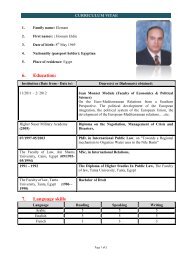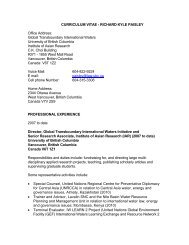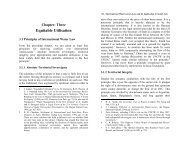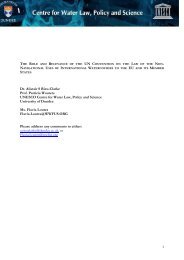Upreti, Trilochan, International Watercourses Law and Its Application ...
Upreti, Trilochan, International Watercourses Law and Its Application ...
Upreti, Trilochan, International Watercourses Law and Its Application ...
Create successful ePaper yourself
Turn your PDF publications into a flip-book with our unique Google optimized e-Paper software.
86 / <strong>International</strong> <strong>Watercourses</strong> <strong>Law</strong> <strong>and</strong> <strong>Its</strong> <strong>Application</strong> in South Asia Development <strong>and</strong> Codification of <strong>International</strong> <strong>Watercourses</strong> <strong>Law</strong> / 87He has given three defences of the ILC commentary, in an ILCeffort to convince the states that hold the above-mentionedview in relation to equitable utilisation. One reason is that itsapproach affords a measure of protection to the weaker statethat has suffered harm. It is not open to the stronger state tojustify a use that gives rise to harm on the ground that it is'equitable'. The second reason is that it is far simpler todetermine whether the 'no harm' rule has been breached thanwould be if water uses were governed in the first instance bythe more flexible (<strong>and</strong> consequently less clear) rule of equitableutilisation. Thirdly, the 'no harm' rule is preferable in casesinvolving pollution <strong>and</strong> other threats to the environment. Whilea state could conceivably seek to justify an activity resulting insuch harm as being 'equitable use', the 'no harm' principlewould- at least prima facie- require the abatement of theinjurious activity. 183If one studied from the outset the adoption of this rule by theILC <strong>and</strong> the UNGA, it is apparent that there have always beendivergent views between the no appreciable harm <strong>and</strong>‘equitable utilisation’ rules. However, harm that threatenshuman health or safety or poses a grave or long-lasting threat tothe environment, should not be protected by the equitableutilisation rule. 184 As demonstrated earlier, the major points ofconflict were that these rules favour upstream or downstream,equitable utilisation versus no harm, whichever rule prevailedover the other, etc. With regard to the conflict between the noharm <strong>and</strong> equitable utilisation, the majority of opinion (in theILC <strong>and</strong> the UNGA discussion) was in favour of equitableutilisation that has been accepted as an established <strong>and</strong>customary law of IWC. 185 However, there is some flexibility in183 Fourth report- on the <strong>Law</strong> on Non-Navigational Uses of <strong>International</strong><strong>Watercourses</strong>, UNGAOR, ILC, 40th session. at 14 UN DOC.A/CN.4/412/Add.2 1988.184 S. C. McCaffrey, "The <strong>International</strong> <strong>Law</strong> Commission Adopt DraftArticles on <strong>International</strong> <strong>Watercourses</strong>" (1995) in 89 AJIL, pp. 395-404.185 II (1) YBILC (1994), pp. 167-168.that some minor injury or harm may occur when equitableutilisation is being made by a state that may result in anerroneous benefit, while at the same time, it may cause minorinjury to the other watercourse state. Such an example would bethe case of a watercourse state that builds a dam, which wouldprovide hydroelectric power to hundreds of thous<strong>and</strong>s of peoplebut would cause significant harm to a few hundred people inanother riparian state whose recreational fishing would bedestroyed. Taking into account the factors listed in Article 6,the most likely conclusion would be that in this hypotheticalcase, the construction of the dam was reasonable <strong>and</strong> equitableeven though it caused significant harm to the other riparianstate. However, maximum attention should be given toeliminate, mitigate <strong>and</strong> reduce the harm to the other riparianstate, by the work of upstream state. 186In the long run, however, 'appreciable harm' was not definedbut was replaced by 'due diligence' in the ILC's final adoptionof the rule in 1994. 187 With regard to the no appreciable harmview, the harm could not become the subordinate rule ofequitable utilisation. Rather, harm caused by a watercoursestate to the other state should be dealt with seriously <strong>and</strong>severely. However, from the ILC commentary, 188 whilesupporting the notion of no appreciable harm, three cases aregiven, namely, the Corfu Channel case, the Trial Smelterarbitration, <strong>and</strong> Lake Launox arbitration. The only case, whichis directly related to a watercourse, is the Lake Lanouxarbitration between France <strong>and</strong> Spain.The critique of this no harm rule is given in the example ofArticle IV of US-Canada 1909 Boundary Water Treaty, whichprovides that ‘the waters herein defined as boundary waters <strong>and</strong>waters flowing across the boundary shall not be polluted on186 Ibid. pp. 167-189.187 Ibid.188 Ibid.












